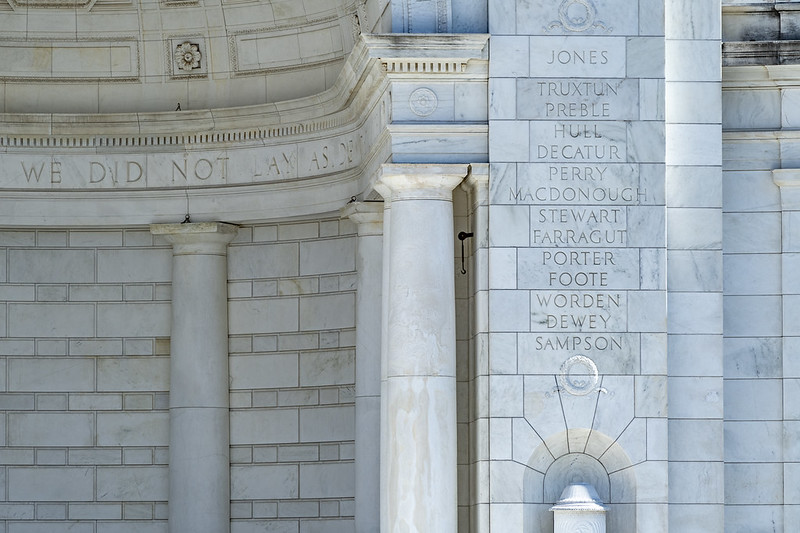3. U.S. Navy Admirals

At the top of the monumental pilasters on each side of the stage, inscriptions list the names of famous figures in American military history: generals on the north side, admirals on the south side. The names are arranged chronologically, beginning with the American Revolution and ending with the Spanish-American War.
John Paul Jones: Naval hero of the American Revolution (1775-1783) often referred to as the father of the United States Navy. He is best known for the 1779 naval battle between his ship, the Bonhomme Richard, and the British ship the HMS Serapis, in which he reportedly told the enemy “I have not yet begun to fight” when he refused to surrender.
Thomas Truxton: Served as a privateer for the United States during the American Revolution. After Congress established the Department of the Navy in 1798, he received an appointment as one of the U.S. Navy’s first six captains.
Edward Preble: Naval commodore during the First Barbary War (1801-1805) who led American attacks on Tripoli in 1804.
Isaac Hull: A commodore in the U.S. Navy, Hull saw service during the Quasi-War with France (1798-1800), the Barbary Wars (1801-1815) and the War of 1812 (1812-1815). He became a national hero as commanding officer of the USS Constitution when he defeated the HMS Guerriere during the first frigate battle of the War of 1812.
Stephen Decatur: A renowned U.S. Navy officer who saw action during the Quasi-War with France, the First and Second Barbary Wars and the War of 1812.
Oliver Hazard Perry: After service in the Quasi-War with France and the First Barbary War, Perry secured a great naval victory during the War of 1812 when he won the Battle of Lake Erie in 1813. He later served in the Second Barbary War and died of yellow fever during an 1819 mission to South America.
Thomas MacDonough Jr.: Served in the Quasi-War with France and the First Barbary War. During the War of 1812, he commanded American naval forces during the naval victory at the Battle of Lake Champlain in 1814.
Charles Stewart: A long-serving officer in the U.S. Navy who saw service during the Quasi-War with France, both Barbary Wars and the War of 1812. He became a rear admiral on the retired list in 1862.
David Glasgow Farragut: After joining the Navy in 1810, Farragut served in the War of 1812, the Mexican-American War (1846-1848) and the Civil War (1861-1865). He is best known for his 1864 victory in the Battle of Mobile Bay, Alabama during the Civil War.
David Dixon Porter: The son of Commodore David Porter (a naval hero of the War of 1812) and the foster brother of David Farragut, Porter served with distinction during the Mexican-American War and the Civil War and was appointed superintendent of the United States Naval Academy in 1865.
Andrew Hull Foote: Serving with distinction from 1822 until his death in 1863, Foote was one of the first naval officers to be promoted to the new rank of rear admiral in 1862. During the Civil War, the “gunboat commodore” commanded naval forces on the western rivers and led attacks against Forts Henry and Donelson. He was also a vocal advocate of temperance and the abolition of slavery.
John Lorimer Worden: Worden served during the Mexican-American War and the Civil War. In March 1862, as commander of the USS Monitor, he engaged the Confederate ship Virginia in the Battle of Hampton Roads, the first battle between ironclad steamships.
George Dewey: As commander of the U.S. Asiatic squadron during the Spanish-American War (1898), Dewey led the attack that destroyed the Spanish fleet in the Battle of Manila Bay. This victory enabled the United States to take possession of the Philippines. Dewey also served with distinction in the Civil War. In 1903, he was commissioned Admiral of the Navy, and he remains the only U.S. officer to have held that rank.
William Thomas Sampson: Sampson is most famous for leading major actions in the Spanish-American War, including the blockade of Cuba and the Battle of Santiago de Cuba. He also fought in the Civil War and served as superintendent of the United States Naval Academy.
.jpg?ver=2020-05-13-085751-393)